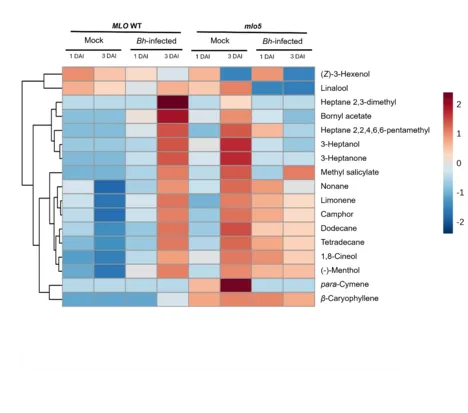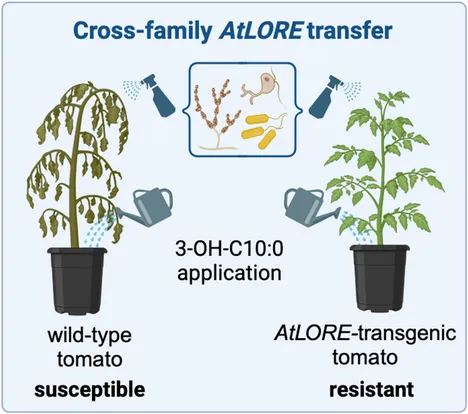One receptor for two effectors! New preprint output from Marion´s Zurich collaboration! https://doi.org/10.1101/2025.10.26.683672
New paper and new preprint on chemical diversity of barley defense compounds in interaction with parasitic ascomycetes. Great collaboration with Corinna Dawid´s lab and others.

The ROP GTPase RACB has been co-immunoprecipitated with two host phospholipid-metabolizing enzymes and one fungal effector that influences pathogen interaction. All three modeled protein complexes share an overlapping binding interface with RACB. [The Plant Journal]
Marion published a nice review on Blumeria virulence effectors together with our collegues from Cologne. Congratulations! https://doi.org/10.1094/MPMI-12-24-0155-FI
Together with Aurelien Tellier as the spokesperson and the BarleyCOPA consortium, Christina and Ralph acquired funding for 4 years research on barley x Fusarium x genotype x genotype x environment interactions. Welcome to our new doctoral candidates Jizhou and Mohamad. https://www.pflanzenforschung.de/de/forschung-plant-2030/projekte/391/detail
Together with colleagues from Zurich, Marion managed to establish the coolest method on earth to identify avirulence effectors …… https://doi.org/10.1371/journal.ppat.1012799

Apparently, barley plants can sense via their volatiles whether their neighbors are susceptible or resistant to powdery mildew. https://doi.org/10.1111/ppl.14646
In humans and animals, cytokines have been described as small proteins (peptides) for their hormone function in the control of various processes, including the control of the immune system. Martin´s group now found that plant CEP phytocytokines link plant immunity and nitrogen status [NATURE Communications]. [and more]

The fatty acid receptor LORE confers resistance to diverse pathogens when expressed in tomatoes. https://doi.org/10.1111/mpp.70005
Created with biorender.com
The new edition of Agrios´ Plant Pathology text book came out with contributions of Ralph Hückelhoven and colleagues on mechanisms and genetics of plant diseases and immunity.
Congratulations to Martin Stegmann who is leaving us for a W3-professorship at University of Ulm by April 2024.

Congratulations to our shared first authors Felix and Christina and all contributors for this important step towards understanding double drought and Fusarium stress responses in barley. doi.org/10.1093/jxb/erad348

Congratulations to Tina Steidele for her shared first authorship on microbial small cysteine-rich peptide elicitors and convergent evolution of their preception in plants. https://doi.org/10.1038/s41467-023-39208-8

The labs of Corinna Dawid and Ralph Hückelhoven joined forces to study the function of wound-induced volatiles in plant to plant signalling. https://doi.org/10.1111/plb.13487

Adriana Trutzenberg developed a RAC/ROP activity assay and shows that GEF14 is an activator of RACB in barley susceptibility to powdery mildew. BEST STUDENT PAPER in Mol. Plant Pathol. https://doi.org/10.1111/mpp.13246

Martin Stegmann and his team found golven peptides to modulate immune receptor abundance and signalling. EMBO Rep. https://doi.org/10.15252/embr.202153281

Lukas Weiß proved in vitro and in vivo posttranslational modifications of the ROP GTPase RACB. Thanks to the Küster and Kumlehn labs for great support. PLOS one: https://doi.org/10.1371/journal.pone.0258924
Congratulations to Remco Stam, who is leaving us by april 2022 to join University of Kiel as a full Professor for Phytopathology.
Congratulations to Steffi Ranf, who is leaving us by february 2022 to join University of Fribourg as a full Professor for Plant Sciences. Good part of her group stays to continue the successful work on MAMP triggered immunity.
Remco Stam and friends edited a focus issue on Population Genomic- and Phylogenomic-Enabled Advances to Increase Insight Into Pathogen Biology and Epidemiology, published in PHYTOPATHOLOGY.
Congratulations to Felix Hoheneder for his first first author peer-reviewed paper on the effect of host genotypes and drought on Ramularia leaf spot of barley [more]

The receptor-like kinase MIK2 apparently functions as a Fusarium elicitor receptor [more]
Ralph Hückelhoven published a new Humboldt review on plant immunity with Isabel Saur from MPI Cologne.

New Review on ROP signalling!


Martin Stegmann, a former postdoc in the Zipfel lab at Norwich, continued here at TUM working on structure-function analysis of the FERONIA-LLG1/2-RALF23 receptor complex in Arabidopsis immune signaling. Data support an unexpected mechanisms of how plants bind RALF ligand peptides for regulating growth and immunity. For more details, read the original article published in NATURE.
Plants sense bacterial metabolite for triggering immunity (SCIENCE)


New comment on how the receptor kinase FERONIA promotes translational and transcriptional programs via EBP1 (more).
New paper on neofunctionalized retrotransposon from Blumeria graminis. Junk DNA revival! (more)
Barley alcohol dehydrogenase 1 helps powdery mildew and limits pattern-triggered systemic immunity (more).

NADPH oxidases are believed to function plant immunity to biotrophic pathogens. Now, we show that a barley NADPH oxidse has a leaf-age dependent function in either resistance or susceptibility to powdery mildew (more).


